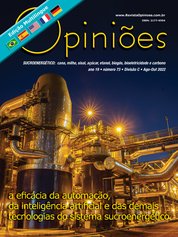Caroline Rabelo Costa Donadon e Simone Cristiane Brand
Diretoras da PlantCare Pesquisa Agrícola
OpAA73
Doenças: fatores limitantes de produção
A tecnologia sempre foi uma ferramenta almejada em diferentes setores do mundo moderno, e não poderia ser diferente quando se trata do agronegócio. O uso incessante por mecanismos que aumentem a produtividade, qualidade de produtos, logística eficiente, entre outros, tem colocado o Brasil em uma posição de destaque no cenário agrícola mundial.
O Brasil é o maior produtor mundial da cana-de-açúcar; juntamente com o título, tem-se os desafios que acompanham o crescimento e liderança do País. Dentre esses desafios, alguns merecem destaque, como diminuição das terras aráveis e necessidade de melhorar a produtividade dos cultivos agrícolas.
A cultura da cana-de-açúcar apresenta características que fazem com que a qualidade sanitária da muda seja de particular importância.
Trata-se de uma espécie propagada vegetativamente, portanto mais passível de transmissão de doenças como mosaico, raquitismo-da-soqueira, escaldadura-das-folhas, carvão e estria-vermelha, doenças estas propagadas pela muda. O setor canavieiro tem evoluído devido à extensa pesquisa no desenvolvimento e aproveitamento de produtos na área industrial, além das inovações agrícolas. Entretanto algumas práticas não acompanharam esse cenário evolutivo, incluindo o uso de colmos (rebolos) como unidade propagativa para instalação do canavial, cujo método remonta à introdução da cultura no Brasil.
Infelizmente, a grande maioria das áreas de renovação, aproximadamente 70%, ainda é plantada com “mudas” originárias de canaviais comerciais, as quais são veículos de introdução de doenças desde o início do cultivo, podendo prejudicar a produtividade e a longevidade da cultura no campo em até 30%.
Com a implantação de canaviais utilizando mudas pré-brotadas (MPB), esse problema é minimizado, mas apenas com técnicas como a cultura de meristemas podemos atestar a produção de mudas verdadeiramente livre de doenças.
Na produção de mudas de qualidade sanitária, fica evidente o papel da automação, visto que são empregados equipamentos, técnicas e pessoal qualificado. A cultura de meristemas envolve, de forma resumida, as etapas de termoterapia, indexação e micropropagação, promovendo a limpeza do material propagativo, ou seja, a produção de mudas livres de doenças, como raquitismo-da-soqueira, vírus do mosaico da cana-de-açúcar (SCMV) e vírus do amarelinho da cana-de-açúcar (SCYLV).
Além disso, a partir de um único meristema apical, podem ser produzidas milhares de mudas em um período de seis meses. A técnica tem levado inclusive à implantação de biofábricas nos EUA, Europa e Ásia, propiciando uma produção anual de mudas de elevada qualidade genética e sanitária.
De acordo com a Organização das Nações Unidas para a Alimentação e a Agricultura (FAO), as perdas anuais na agricultura são da ordem de US$ 314 bi com pragas e doenças em seis países, incluindo o Brasil.
Condições ideais de clima e cultivos agrícolas em quase todo o território nacional, praticamente o ano todo, tornam o país um reservatório de agentes causais de doenças cujos danos levam a perdas, quando não controlados, de até 100%. Essas perdas são desastrosas quando se leva em consideração o custo de produção e o patamar onde se encontra o Brasil, dentre os países exportadores de produtos agrícolas, deixando de ser competidor e gerando déficit econômico.
As doenças são fatores limitantes de produção e preocupantes desde os primórdios, quando a agricultura era ainda de subsistência. Com as tão necessárias revoluções que aconteceram na agricultura, consolidou-se o desenvolvimento de ciências sobre os patógenos e suas relações com as plantas, o manejo das doenças através de diferentes formas de controle que melhor contemplava os patossistemas diversos.
Algumas inovações no manejo das doenças vêm sendo desenvolvidas. Uma tecnologia apresentada recentemente para o controle da doença podridão vermelha, causada pelo fungo Colletotrichum falcatum, é a chamada Tecnologia do Consórcio Probiótico (TCP). A TCP é uma tecnologia de estabilização de microrganismos, gerando soluções à base de ecossistemas ou microbiomas criados a partir dessas estabilizações.
As soluções podem ser de microrganismos, metabólitos, ou de ambos. De acordo com o pesquisador José Melhado Sanches, integrante do projeto, estudos in vitro atestaram que o uso da TCP para controle do C. falcatum obteve controle acima de 80% em todas as dosagens, ao 6º dia, e, ao 12º dia, acima de 90%.
Estudos de campo estão sendo conduzidos para corroborar os realizados em laboratório. Constatando que o uso de TCP pode controlar o fungo nas lavouras de cana-de-açúcar acometidas por tal patógeno, será uma importante ferramenta no controle do fungo, que pode causar perda de 50 a 70% da sacarose de colmos atacados simultaneamente pelo fungo e pela broca-da-cana, além de reduzir a produtividade e a qualidade da matéria-prima. Tal informação sugere que é possível que a aplicação preventiva realizada no solo possa ajudar no controle do Colletotrichum e de outras doenças, além de incrementar a produtividade.
Somente com evoluções desses níveis, podemos atingir patamares de produtividade de três dígitos em áreas expressivas de cultivo e melhorar a longevidade da cultura no campo.




